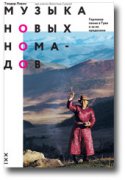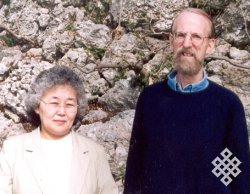 A new book by Theodore Levin, professor, well-known producer, ethno musicologist, researcher, and promoter of the musical culture of the Inner Asia, will catch the interest of those, who live in Tuva and will be read over by everyone, regardless of their relation to music. The book under the title Where Rivers and Mountains Sing: Sound, Music, and Nomadism in Tuva and Beyond was published in America in 2006.
A new book by Theodore Levin, professor, well-known producer, ethno musicologist, researcher, and promoter of the musical culture of the Inner Asia, will catch the interest of those, who live in Tuva and will be read over by everyone, regardless of their relation to music. The book under the title Where Rivers and Mountains Sing: Sound, Music, and Nomadism in Tuva and Beyond was published in America in 2006.
Theodore Levin presents several points of view of different scientists on the fate of nomad musical art and, especially, of the gained worldwide popularity, the art of throat singing. The author anticipates and fears the commercialization and the loss of genuine nature of khoomei because of the music performers chasing the inviting success.
The Russian version of the book called Музыка новых номадов. Горловое пение в Туве и за ее пределами has just been released in Moscow. Valentina Suzukey, famous ethnomusicologist, doctor of culturology, the author of several works on traditional folk music and Tuvan musical instruments, had considerably been collaborating in working on the book.
One of its first scenes describes the Huun-Huur-Tu ensemble concert in the American city of Santa Fe (New Mexico), and the last chapter is dedicated to their stay on the Crete Island within folk music festival.
The author repeatedly quotes the folk myths, legends, fables, tales, and songs to show the relation of Tuvan people to the music and the talent of a performer. The pictures of the book’s characters are amazing in their distinctiveness like characters of outstanding khoomei performers Kaigal-ool Khovalyg, Kongar-ool Ondar, Gennagy Tumat, the scientist Mongush Kenin-Lopsan, etc.
Theodore Levin first travelled to Tuva back in 1987 and 1989, and at that time he was assisted on his expeditions by Tuvan musicologist Zoya Kyrgys, who is now a doctor of art criticism and author of monograph Tuvan throat singing.
 Mr. Levin’s main interest is musical culture of peoples of the Inner Asia in general. He used to work a lot in Uzbekistan, Kazakhstan, Kyrgyzstan, Khakassia, Mongolia, and Altay. However, the ¾ of the total monograph size is dedicated to the Tuvan musical culture, mainly to throat singing, to its types and to the performers of the remarkable art. Is there any reason why Tuvan folk music of all others has become the object-matter for the scientist? Through the whole book the author continually expresses the same thought – it’s necessary to visit and to study the musical art of those parts of the world, where people keep on living in strong connection with nature, where traditional folk music culture hasn’t become an anachronism, a “dying nature”. Tuva has become the very place for Levin, where he has found truly folk performers taught the art by their relatives or senior masters of khoomei. The author regretfully notes, how little was done in keeping and appreciating the folk music during the Soviet period, the way the authorities aimed to adjust the original folk music to a single standard, how pseudo-folk ensembles and orchestras, or “cultural dinosaurs” according to Levin, were formed, and how khoomei was considered to be a relic of the past.
Mr. Levin’s main interest is musical culture of peoples of the Inner Asia in general. He used to work a lot in Uzbekistan, Kazakhstan, Kyrgyzstan, Khakassia, Mongolia, and Altay. However, the ¾ of the total monograph size is dedicated to the Tuvan musical culture, mainly to throat singing, to its types and to the performers of the remarkable art. Is there any reason why Tuvan folk music of all others has become the object-matter for the scientist? Through the whole book the author continually expresses the same thought – it’s necessary to visit and to study the musical art of those parts of the world, where people keep on living in strong connection with nature, where traditional folk music culture hasn’t become an anachronism, a “dying nature”. Tuva has become the very place for Levin, where he has found truly folk performers taught the art by their relatives or senior masters of khoomei. The author regretfully notes, how little was done in keeping and appreciating the folk music during the Soviet period, the way the authorities aimed to adjust the original folk music to a single standard, how pseudo-folk ensembles and orchestras, or “cultural dinosaurs” according to Levin, were formed, and how khoomei was considered to be a relic of the past.
Admittedly, the author is unimpressed with the cultural politics of the soviet period in general, saying not only about destroying tendencies in folk musical culture, but also pointing out the apathetic and soulless attitude to culture in much wider sense, for instance, to people’s everyday environment. Scuffed and untended five storey buildings in the city (like the apartments where only poor people live in America), rubbish on the streets, poor architecture in villages, built when Tuvan nomads were switching to a more settled lifestyle strike his eye. Well, we need to admit, that onlooker sees most of the game, while we have got used to and do not notice all of it, or simply have accepted it.
Analyzing sound imitations of wildlife (mimesis) in Tuvan folk music Theodore Levin has made a conclusion that not only in the fine art, but also in the music of nomads there is an “animal style”.
Through the whole narration, he follows up the connection between the people’s history, natural environment, and music.

